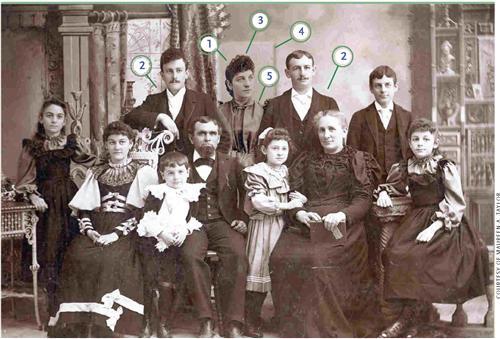Sign up for the Family Tree Newsletter Plus, you’ll receive our 10 Essential Genealogy Research Forms PDF as a special thank you!
Get Your Free Genealogy Forms
"*" indicates required fields
Think photo-editing tips and tricks were born of the computer age? Forget that notion — the art of altering images is as old as photography itself. Well-known Civil War photographer Mathew Brady took a group portrait of Gen. William Tecumseh Sherman and his generals against a plain backdrop; later, he added one more general and a different background. Another enterprising photographer stuck Abraham Lincoln’s head on the bodies of notable 19th-century personalities such as John C. Calhoun, Alexander Hamilton and Martin Van Buren, and sold the reconstructed images as memorial pieces after Lincoln’s assassination. Don’t have a photograph of Aunt Edna? Perhaps disgruntled relatives edited her out of the family portrait.
Dino A. Brugioni, a founder of the CIA’s National Photographic Interpretation Center and the author of Photo Fakery: The History and Techniques of Photographic Deception and Manipulation (Brassey’s) has identified several types of photo trickery. The most common involve adding or removing a person or object from an image. A photographer could subtract a person by cutting the negative or painting over part of it with a chemical, or simply by creatively cropping the print. People also made cosmetic enhancements to their photos, such as hand-coloring the image or using pens to improve a subject’s facial features.
More-intrepid photographers blended different images into photo montages. If illness or distance prevented a relative from joining a group portrait, that person might pose separately. A photographer would then combine the two negatives. Another example: old-time “spirit” photographs featuring a casket with a ghostly inset of the deceased. Those images didn’t result from supernatural phenomena — a photographer simply superimposed an earlier portrait over the coffin.
You may not realize whether your family photo collection contains pictures altered by your ancestors. Some cases are obvious; if the manipulator did a better job, though, you’ll need a sharp eye to spot the clues. Find the “fakes” among your photos by examining each one for the following details. See my picture above for examples.
An out-of-place person or object. Look carefully at the woman in the back row of this unidentified group portrait. Notice anything different about her? She’s standing at a different angle from the rest of the group and looking in another direction.
Odd positioning. Notice how the photographer posed the men next to the woman with a wide space between them, which would make it easy to insert another photo. It suggests the family probably planned this alteration. Your album might feature examples of a photograph both before and after changes.
Differences in proportion and color. This woman also stands out because her head and shoulders are larger than everyone else’s. Her face is gray; everyone else’s is light. Examine shadows in your photos: If the light casts a shadow on a different side of one subject’s face, she may have been added to a group shot.
Visible seams. Here’s the most obvious evidence of a photo manipulation. Old-time photo-editing techniques didn’t allow for smooth blending of multiple images. Look around the woman’s head and shoulders, and you’ll see the rectangular outline where the two pictures meet. Also check your pictures for strange shadows or different-colored background areas — a telltale sign that someone removed a person or object.
Details that don’t add up. Fashion and family history clues can provide dates that help determine the truthfulness of a picture. Here, the puffed shoulders on the out-of-place woman’s dress were popular around 1891. The other women’s outfits feature generous sleeves on the entire upper arm, which date from the mid-1890s and give us a time frame for the picture. Such disagreement of fashion details is further testimony this image was altered. Once you have an idea of a photo’s date, watch for individuals who shouldn’t be in the picture, as well as those who should be but aren’t. For instance, if clothing clues suggest a date long after someone in the picture died, that person probably was added later.

Trace Evidence
1. Someone doesn’t belong. This woman is standing at a different angle and looking in another direction from everyone else.
2. Subjects are spaced oddly. The wide distance between these men suggests a plan to insert an image into the finished print.
3. One person is a different size or color. Her relatively large head and dark face show this woman was photographed in another setting with different lighting.
4. Seams are obvious. A line such as this one is a dead giveaway that two images were combined.
5. Costume clues yield inconsistent dates. This woman’s dress dates to about 1891; the others’ outfits are from the mid 1890s. She may have sat for her portrait earlier than the rest of the group.
ADVERTISEMENT

